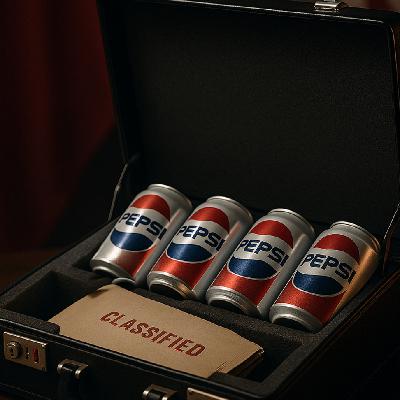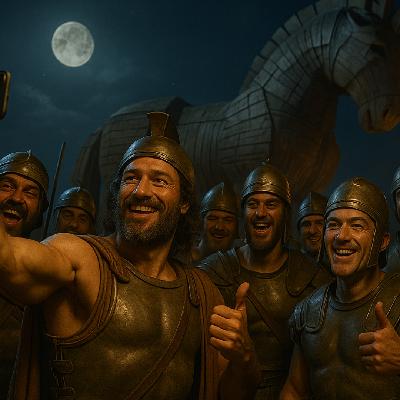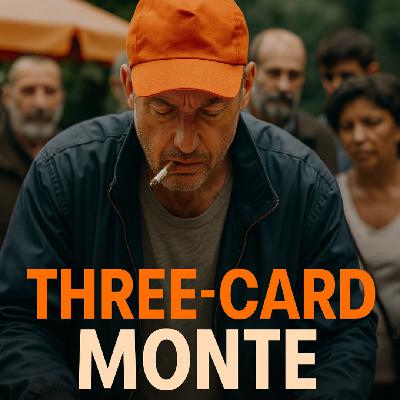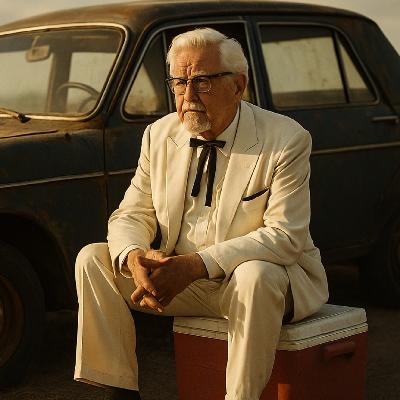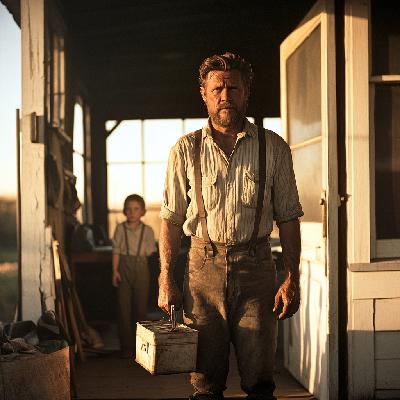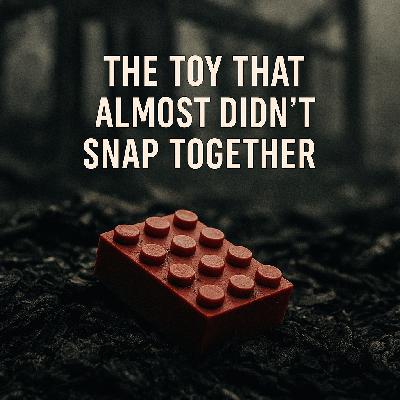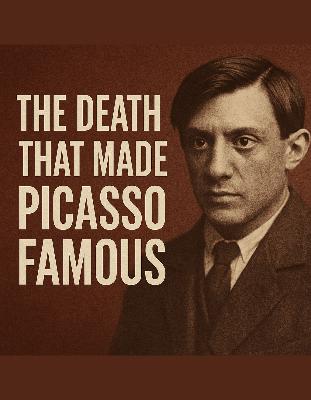Discover The Conant Code
The Conant Code

The Conant Code
Author: Paul Conant
Subscribed: 1Played: 41Subscribe
Share
© Copyright 2025 All Rights Reserved
Description
The Conant Code brings history’s most surprising stories to life, blending unexpected twists with modern-day lessons in business, life, and strategy—all in quick, punchy episodes. Written and produced by Paul Conant, each story unravels like a mystery, building suspense and ending with a twist that’ll leave you rethinking what you thought you knew.
From billion-dollar ideas born out of scandal to the untold origins of everyday traditions, The Conant Code is your go-to for sharp, thought-provoking stories with takeaways you won’t forget.
Curious? Tune in and discover your next big insight.
From billion-dollar ideas born out of scandal to the untold origins of everyday traditions, The Conant Code is your go-to for sharp, thought-provoking stories with takeaways you won’t forget.
Curious? Tune in and discover your next big insight.
53 Episodes
Reverse
There's a new medical condition out there? No, you're not going to find this in the DSM. That's the Diagnostic and Statistical Manual of Mental Disorders, the big book that doctors use to label everything from a quirky anxiety to restless leg syndrome. So no, you're not going to find it there. Not yet. But it should be. It's called Artificially Induced Contrarian Disorder, AICD. And it's serious. It's the world's first sickness spread entirely through Wi-Fi and mobile phones. Here's how it works. You post something online. It could be business, sports, politics. Doesn't matter. And here comes the troll. Only this isn't your average basement philosopher. Oh, no, no, no. This one copies your post, pastes it in the chat GPT or some other AI, and types, debate this. Make me look smart. Seconds later, out pops a perfectly polished rebuttal. Neat stats, percentages, analogies, even a sprinkle of history. Suddenly, you're not debating a person. You're debating Microsoft Word with an attitude problem. So who are these people? Well, let's be honest. They're not the thinkers. They're recyclers. They don't build ideas. They lease them. Short-term rental. No down payment. It's like watching a guy in the stands yell coaching tips at a kid's basketball game. Loud, arrogant, couldn't even make his own high school JV team. But there he is, Rick Pitino. And don't get me started on these idiots. I'll save that rant for another episode. Why are they like this? A simple debate takes effort, reading, thinking, and maybe even a little humility. And effort is expensive. So instead, they outsource their ego to an algorithm. It's the intellectual version of hiring a stunt double to run a marathon for you. Or paying someone else to do push-ups while you sit at the snack bar. And here's the scary part. It's only going to get worse. Right now, they're just copying and pasting your post in the chat GPT. Soon, they'll unleash little clone bots that crawl social media day and night, scanning every thread, spitting out arguments on their behalf. You won't be fighting one troll. You'll be fighting a digital troll army 24-7. Multiply that times millions of idiots and suddenly the future looks... Amazing. I can't wait. It'll be like watching real housewives 24-7 on repeat. Same drama, same yelling, no plot, and somehow louder. And imagine how far it goes. By 2030, you won't be just using AI for debates. You'll be using it for everything. You'll be at a wedding and the vows will sound suspiciously like a chatbot. I promise to love you, long dash, according to the top five bullet points I generated for internal commitment. Then the groom will add, I may not always understand you, but here are the alternative phrasings of my devotion. That's where we're headed. Love, honor, cherish, and all optimized for readability on a seventh grade level. So yes, they look human. They sound human. But don't be fooled. They're digital ventriloquist dummies. And the hand inside them, it's not theirs. It's a chatbot. So let's give it a clinical definition. Artificially induced contrarian disorder. AICD. It's the compulsive urge to outsource your bad arguments to artificial intelligence. Symptoms include compulsive rebuttal syndrome. If you say the sky is blue, they reply, technically it's light refractions through the nitrogen molecules. Copy-paste dependency. Their fingers twitch if they can't control C or control V your words into a chatbot. Winkipedia warrior syndrome. Monday, they're an economist. Tuesday, a physicist. Wednesday, a dog groomer. Same fake authority, different oral brain. And my favorite symptom, chronic hedging. Their big comeback is always, well, time will tell, which means I don't know what I'm talking about, but the chatbot said it, so I win. Now, here's why it should be a real disorder. Because you can't beat them. Ever. You poke a hole in their argument, they reload. You point out the facts don't match reality, they resubmit. It's endless. They've turned debate into a vending machine. You push a button, and another lukewarm argument clunks out at their feet. And the scary part? They think they're winning. They actually believe they're smarter because they've outsourced their thinking to software. Imagine arguing with the vacuum cleaner that brags how much dirt it could hold. That's exactly what this is. Let's be clear. This isn't intelligence. It's parroting. They repeat phrases they don't grasp, acting like geniuses, while the machine gushes out information they couldn't produce in a lifetime, even with Google. And you? You're the poor soul standing there trying to reason with the vacuum cleaner. By the way, you don't beat the vacuum cleaner by sucking louder. You win by pulling the plug. So here's the lesson. Artificially induced contrarian disorder isn't in the DSM, but it should be. Because if you can diagnose restless leg syndrome, surely we could diagnose restless reply syndrome. The prescription is simple. Block twice a day, delete as needed, and move on before you catch AICD yourself because it's highly contagious. The second you feel like copying the comment and going to the chat GPT tab on your computer getting ready to add your two cents, put the mouse down, step away, and attend your first meeting of commenters anonymous. Also, not a real thing yet. So remember, you can't out argue the copy machine, because all it does is copy. And if you spend your time debating with a copy machine, the only thing that gets duplicated is your own stupidity. So do yourself a favor, unplug it, and move on. And that, my friends, is the Conant Code.
Most people think of Labor Day as barbecues, sales, and the end of summer.
But the truth? It was born from blood, sacrifice, and a fight for dignity in the workplace.
This week on The Conant Code, we dig into the forgotten roots of Labor Day, why it exists, what it cost, and why remembering matters more than ever.
Welcome to the Conant Code in todays episode we discuss social media kindness. and address the question if you're helping someone, why put it on Facebook? You're doing it for likes and validation, not out of kindness. Her question sent me down a rabbit hole a brief, sharp investigation into what happens when kindness gets an audience.
We tell the scene like this: someone films themselves handing a sandwich to a stranger, another posts a selfie with a donation check, a long caption announces a covered grocery tab. It's not always malicious, but it's familiar. Psychology gives it a name virtue signaling and our brains give it a reward: dopamine, the same spark for winning, sugar, and love. When doing good starts to feel like winning, the act shifts. The rush can become the point.
History offers a contrast. Carnegie stamped libraries with his name, Rockefeller built foundations legacy projects meant to outlast a lifetime. Social media offers something different: likes that evaporate in 48 hours. Legacy builds a future for others; likes build a moment for you. And when helping becomes performance, the center of gravity moves from the person in need to the person with the camera, training everyone to see assistance as transactional.
That shift matters for business, too. Brands launch charity campaigns and sustainability initiatives that live only as press releases and photo ops. Real trust, however, is built quietly in consistent behavior, not in curated announcements. The best companies don’t advertise values; they live them until customers and communities tell the story for them.
The episode closes with a simple test: before you post, ask yourself is this for them or for me? Because true kindness doesn't need an audience, and real leadership is proven when no one's watching.
If this episode landed, share it with a friend, follow the show, and leave a review on your favorite podcast platform. That, my friends, is the Conant Code.
Success isn't random. It follows a code. Welcome to the Conant Code — a five-minute crack at the small, strange choices that turn into big, durable advantages. This episode opens with a single, odd scene: a Boston workshop in 1845, where Peter Cooper, the man who built America’s first steam locomotive, is boiling animal parts. Not to make soup, but to hunt for something hidden in bone and skin: collagen that, once powdered and mixed with water, becomes a wobbly, improbable gel.
Cooper patents his accidental discovery, flavors it, and then walks away. For half a century it sits forgotten until Pearl Waite, a humble cough-syrup and laxative salesman from LeRoy, New York, sees an opportunity. Pearl and his wife add sugar and bright flavors, give the product a name — Jell-O — and try to sell it door-to-door. Nobody cares. Then he does something quietly brilliant: he gives it away.
Pearl’s free recipe booklets, handed to housewives and slipped into pantries, do more than advertise a dessert. They make Jell-O a habit. Once it lives on the shelf, it becomes part of the family story. By 1904 sales are $250,000; by the 1930s Jell-O has woven itself into the fabric of American life — even showing up in a Norman Rockwell painting, the Instagram of its day.
And then comes the yuck factor: Jell-O has never been vegetarian. It’s made from gelatin, processed collagen pulled from hides, bones and connective tissue of pigs and cows. The material is cleaned, boiled, acid-treated, dried and powdered, then reborn with sugar, dyes and flavorings. If you’ve ever swallowed a soft-gel pill, you’ve eaten the same substance in another outfit. Gelatin is a strange crossroads of recycling, chemistry and appetite.
But gelatin’s life stretches far beyond the buffet. It coated early film, stabilized military rations, and turned up in medicine capsules. In crime labs and ballistics testing, gelatin blocks simulate human tissue — a scientist somewhere is firing a bullet into something that feels exactly like cherry Jell‑O. That image, equal parts gross and fascinating, shows how one material can travel through industry, art and science.
The real lesson — the Conant Code — is not about clever ingredients but about positioning. Pearl didn’t fight for shelf space; he created demand before customers knew they needed the product. He put the product inside people’s routines and let habit do the selling. You don’t always have to sell harder; sometimes you sell smarter: seed the story, make the product part of life, and the rest follows.
By the end of the episode you’ll see Jell‑O as more than a wobbly dessert: it’s recycling, invention, marketing and a lesson in getting inside people’s lives. That’s the code. If this episode cracked something open for you, share it, follow the Conant Code, and keep testing the small moves that create outsized results.
In this episode of the Conant Code, we delve into the fascinating world of Victor Lustig, the con artist who daringly sold the Eiffel Tower not once, but twice. Set against the backdrop of 1925 Paris, a city both vibrant and financially strapped, Lustig's audacious scams offer a masterclass in the art of deception. Listeners will be captivated as they follow Lustig's transformation from a well-dressed gentleman to a conman who made even the most prestigious businessmen falter.
As we unravel the layers of Lustig's scams, we explore the broader themes of trust, persuasion, and the delicate balance between truth and illusion in business. From Lustig's fake government meetings in lavish Paris hotels to his eventual downfall, this episode explores how confidence, exclusivity, and a touch of urgency can create an irresistible narrative, even when built on lies.
But it's not just a historical recount; the episode brings sharp insights into today's market dynamics. It prompts listeners to reflect on modern business practices, where the lines between persuasion and manipulation often blur. The narrative urges you to differentiate between genuine trust and manufactured belief, ensuring you're not caught in the web of modern-day Lustigs, the slick, suit-and-tie personas of today's business world.
Tune in for a journey through time and ethics, where the past and present collide to reveal crucial insights for entrepreneurs, marketers, and consumers alike. Remember, this isn't just history it's a reminder that in the world of business, the stakes of integrity are always sky-high.
This episode dives into the annual cycle of New Year resolutions—filled with hope, ambition, and, ultimately, unmet expectations. It’s not just about what goes wrong but why, with insights from Dr. Robert Mora, who reveals startling statistics: the average person repeats the same resolution for a decade, often failing numerous times before finding a semblance of success.
At the heart of the discussion is the detrimental myth of "go big or go home." Instead of imposing overwhelming change that triggers a reactive fear response, this episode unveils a transformative alternative: Kaizen. Derived from Japanese philosophy, it signifies making small, consistent improvements—tiny steps forward that sidestep fear, avoid drama, and bypass stress.
Listeners are guided through practical tactics inspired by this philosophy, like carrying just enough cash to curb spending habits, or marching in place while brushing your teeth as an entry into fitness. These strategies function not by exhausting the mind's defense mechanisms but by engaging it creatively, keeping the path to change open and active, much like how General MacArthur leveraged small improvements to revolutionize Japan's post-war industry.
The episode further explores the power of mental rehearsal techniques like "mind sculpture," demonstrating how imagining success in vivid detail can bring about real-world change. This mental conditioning empowers individuals to transform daily actions into habits, and habits into a new identity, driving momentum forward.
Whether you're keen on revamping your yearly resolutions or curious about the science behind sustained change, The Conant Code offers insights, inspiration, and the practical wisdom of taking small steps. Dive into the book "One Small Step Can Change Your Life, The Kaizen Way" by Dr. Robert Mora to explore further, join us on this journey, and keep the momentum going. Until next time, keep thinking, building, and pushing forward.
Prepare to be transported back to the late 1980s, a time when the Soviet Union's strength was crumbling under the weight of economic turmoil. In an era where currency mattered less than creativity, PepsiCo executed a daring maneuver that remains one of the most audacious tales of business ingenuity a strategic exchange of fizzy drinks for a formidable naval fleet.
In this episode of the Conant Code, delve into the captivating narrative of how Pepsi, the beverage icon, became momentarily infused with military might. The story begins in the Cold War's shadowed theater, where currency was as volatile as politics, and barter emerged as the savior. Discover how Pepsi's initial partnership with the Soviet Union, sealed with a toast at the 1970s Moscow trade show, blossomed into an unexpected Cold War alliance.
As the Soviet economy plummeted, vodka transformed into the currency of choice, leading Pepsi to become the exclusive U.S. distributor of Stolichnaya vodka. This exchange of goods set the stage for an incredible escalation in 1989. Facing dire economic constraints, the Soviets sought to renew their agreement, this time with warships on the bargaining table. Pepsi's acquisition of 17 submarines, alongside other naval vessels, was not a ploy for power but a stroke of capitalist genius. They swiftly scrapped the fleet, favoring soda sales over naval supremacy.
Join us as we unravel Pepsi’s maneuver through the socio-political landscape, redefining what it means to negotiate and strike deals. Witness a masterclass in seeing beyond the conventional where Pepsi, unfazed by geographic and ideological boundaries, embraced the extraordinary to secure its global presence. Learn why Pepsi's operations in Red Square stood as a testament to its daring strategy while Coca-Cola remained a spectator, tied to traditional notions of commerce.
This narrative isn't just an anecdote; it's a timeless lesson in innovation and boldness, reminding us that every deal holds potential far beyond its surface value. Let the Conant Code inspire your own ventures because in the world of business, when a soda company can trade cola for cruisers, anything is possible.
In this episode of the Conant Code, we unravel the hidden strategies that transformed Prego from an underdog to a market leader in the world of tomato sauces. Join us as we venture back to the early 1980s, a time when Ragu dominated the shelves, and Prego's prospects appeared dim. Faced with flat sales and customer indifference, Campbell's, the parent company of Prego, took a bold step by enlisting the expertise of Howard Moskowitz, a Harvard-trained psychophysicist.
At the heart of this transformation is Moskowitz's groundbreaking insight: there isn't a one-size-fits-all solution in the quest for the 'perfect' sauce. Instead, the secret to success is diversity, recognizing that the tastes and preferences of consumers vary vastly. With thousands of taste tests and data points, Moskowitz guided Prego to embrace a new paradigm - offering multiple variations on a theme. And the results were sensational. Prego introduced Chunky, Extra Chunky, Garlic and Herb, and more, igniting a revolution that saw them soar to over $600 million in new revenue.
This is not just a story about tomato sauce; it's about understanding choice, consumer psychology, and the profound impact of catering to individual preferences. In our quest to break down myths and uncover truths, the Conant Code delves into how businesses can unlock their own successes with the right strategies, targeted approaches, and a keen understanding of their customers' desires. Step into aisle four, embrace the revelation, and discover how a red tidal wave of options can lead to unparalleled profits and market dominance.
In this episode of The Conant Code, we head back to 1900s Connecticut, where a booming pie company was unknowingly cooking up something far more lasting than dessert. What started as a harmless lunch break game among factory workers turned into a nationwide obsession and eventually, a global phenomenon.
No one planned it.
The founder wasn’t thrilled about it.
And the company? It didn’t survive.
But what they left behind?
It’s still soaring.
Hit play and hear how a humble bakery accidentally launched one of the world’s most iconic pastimes.
What do a blind Greek poet and a bald cartoon dad have in common? More than you'd think. In this sharp, story-driven episode of The Conant Code, Paul dives into The Odyssey and the epic journey of Odysseus—then flips the script with a modern twist: Homer Simpson. It's ancient wisdom vs. modern distraction in a battle for purpose, grit, and meaning. This 5-minute narrative unpacks what it really means to come home, why struggle reveals character, and how our daily choices shape the legacy we leave behind.
If you’ve ever felt stuck, scattered, or like you’re just drifting—this one’s for you.
Which Homer are you living like?
Dive into the world of ingenious marketing with this episode of The Conant Code, where we unravel the iconic story of how Michelin, a French tire company, revolutionized not just the culinary world, but the very essence of marketing strategy. Join us in 1900s France, a land of cobblestones, horses, and the dawn of the automobile, where two visionary brothers, André and Edouard Michelin, embarked on a journey that would forever change the definition of excellence.
In a time when cars were scarce, the Michelin brothers faced an uphill battle to boost tire demand. Their solution was not just inventive but transformative. Discover how they crafted a side-door marketing campaign that ingeniously bridged the gap between tires and taste. By distributing a free guide filled with maps, mechanics, and restaurant ratings, Michelin subtly encouraged drivers to hit the roads, wearing out tires while unwittingly shaping the finest dining experience narratives. Their guide birthed the esteemed Michelin stars that chefs now revere.
Explore the monumental influence of the Michelin Guide, a sleeper hit that grew into the world's most coveted culinary accolade. Witness how Michelin, with silent precision, committed to its mission without the need for celebrity endorsements or over-the-top promotions. The tale of Michelin is a narrative of movement, driven by a roadmap of desire that’s stood the test of time. If you think your product is mundane, think again. Get inspired to craft your own path and lead an audience through curiosity, adventure, and taste.
This episode is not just about revealing a marketing legend but about understanding the intrinsic code of success — the Conant Code. Stay tuned for more insights, strategies, and inspired storytelling that ignite the path to your own legendary impact. Until next time, keep thinking, keep building, and keep pushing forward.
In this episode of the Conant Code, we delve into the fascinating journey of Jeff Bezos, the man who took a leap of faith by leaving a secure hedge fund job to start an online bookstore that we now know as Amazon. Despite facing mockery and skepticism from Wall Street and the press, Bezos stayed focused on his vision, revolutionizing logistics, branding, and customer experience. His story is a testament to the power of relentless execution over mere ideas.
Listen as the Conant Code dismantles the myths surrounding entrepreneurship, laying bare the brutal truth: great ideas are only a fraction of the journey. Hear anecdotes and insights that unravel why guts, grit, and substantial capital are non-negotiable in today's competitive market. With a touch of humor and a dose of pragmatism, you'll learn that the market doesn't reward genius alone—it rewards those willing to make tough decisions and continuously adapt.
This episode urges aspiring entrepreneurs to think beyond the glamorous image of unicorn startups, offering a reality check on what it truly takes to build a successful business. Discover how to navigate the minefield between aspirations and real business, leaving you with a sound strategy to forge your own path to success. If you're ready to move past dreaming and start doing, this is a can’t-miss episode of the Conant Code.
In this episode of The Conant Code, we dive deep into the world of psychological manipulation and marketing tricks that run rampant in our everyday lives. We strip back the layers of modern sales tactics and reveal how these cunning strategies have evolved from the dark alleyways of three-card monte hustles to the bright shopping aisles and glossy advertorials.
Discover the parallels between the seemingly simple card game of deception and the sophisticated schemes employed by today’s marketers. We expose the secrets behind anchoring prices, where overpriced headphones, wine, and even real estate offers are merely ploys to draw your attention and convince you of a fictitious bargain.
This episode doesn’t just entertain; it equips you with the awareness to spot these psychological games and arm yourself against them. As we unravel the complexities of choice and illusion in consumer behavior, you'll learn that the power to recognize and resist these hustles lies within your grasp.
Tune in, and become part of the narrative that empowers consumers to make genuine choices – free from the hidden twists and frames laid out by clever marketers. Are you ready to decode the tricks and take control of your decisions? Join us in this eye-opening journey, and crack the Conant Code!
Welcome to another insightful episode of The Conant Code, where we delve into the intricate layers of history, dismantling myths and uncovering truths in less than five minutes. Set against the backdrop of July 4th fireworks and patriotic fanfare, we unravel the audacious origins of the Declaration of Independence. This episode isn't just about hot dogs and flags; it's about the daring decision to challenge a monarchy, the chaos of colonial discourse, and the unyielding belief in freedom that transformed thirteen colonies into a united nation.
We journey back to a sweltering summer in Philadelphia, where the atmosphere was charged with political tension and personal stakes. It was a time when leaders, despite their disagreements and uncertainties, signed a document that would redefine liberty. Fast forward to today, where social media wars replace colonial clashes, and the debate over freedom takes on new forms. Yet, amidst the digital noise, the core message persists: the pursuit of a shared vision, albeit chaotic, remains central to the American experiment.
Through vivid storytelling, this episode invites you to reflect on the courage it took to break away and the courage it takes to build anew. As you listen, you are prompted to consider where you stand in this ongoing narrative. Are you a builder or a spectator? Join us as we decode the real spirit of Independence Day and challenge you to think beyond the holiday's surface.
Dive into the whirlwind world of infomercials with "The Conant Code," where we unravel the life and legacy of the man behind the legendary tag line, "Set it and forget it." In this episode, we journey through the annals of TV history to uncover how Ron Popeil, with his raw charisma and unparalleled salesmanship, transformed the mundane into the mesmerizing and built an empire from the most unexpected of products.
In the sepia-toned days of black and white TV, while the world saw a box for news and shows, Ron Popeil envisioned a stage—an intimate theater connecting with every home in America. This was not just a man selling gadgets; he was offering dreams, promising time savers that could elevate the everyday person's life. From the Chop-O-Matic to the iconic pocket fisherman, each item wasn't just sold; it was a solution to a problem you didn’t even realize you had.
His genius lay in the narrative, in selling outcomes rather than objects. Ron’s playbook—a formula of identifying a problem, agitating the pain, and delivering a simple yet effective solution with urgency—became the standard for direct marketing, even more relevant today. From $9 million in annual sales in 1968 to $2 billion in lifetime achievements, his story isn't just about success; it's about innovation, about pushing boundaries and understanding human desires.
Join us as we dissect his strategies and adapt them to modern times, showing that sometimes, a little transformation in a polyester suit can inspire a world of change. This isn't just a tale of infomercials—it’s a lesson in marketing prowess, a glimpse into a revolutionary mind, and a roadmap for aspiring entrepreneurs. So, let's crack the code and redefine what success really means.
Welcome to the Conant Code, where ambition meets reality in bite-sized revelations. This episode transports you to the mid-1970s, an era when Kodak was not just a brand but the photography empire itself. From the heart of Kodak's success story emerges a young engineer, Stephen Sasson, who quietly redefines the future of photography with a prototype camera that operates without film.
Imagine standing in a Kodak boardroom, awash with wind of change, holding the future of photography. Yet, fear prevails over innovation, caution over courage, and comfort over disruption. Kodak's leaders witness the revolution in Sasson’s hands but choose silence; a silence that echoes the doom of a dynasty married to current tapestries, blind to the approaching digital storm.
As you trace Kodak's journey from dominance to downfall, unravel the intricacies of what went wrong—an internal battle where innovation was shelved and opportunity overlooked. Meanwhile, global rivals like Sony and Canon seized the whispers of change, advancing technology to the digital frontiers that Kodak hesitated to lead.
Join us for this illuminating narrative that not only scrutinizes a corporate giant’s missteps but also compels you to reflect: what golden goose are you defending today? The Kodak saga teaches us the hard truth: when leadership becomes a custodian of bygone systems, innovation efforts die in the shadows. Remember, the disruption you ignore today is the tidal wave of tomorrow.
Stay tuned for more insightful breakdowns, more strategies and more codes unveiled in our next episodes. Until then, keep questioning, keep innovating, and never settle in comfort.
At 62, Harlan found himself living out of a run-down car, nearly defeated and carrying a cooler full of raw chicken, hoping for a chance. He had tried it all—farmhand, lawyer, gas station operator—only to face failure after failure. But there was something about Harlan that refused to give up.
As he drove from restaurant to gas station, pitching his meticulously crafted chicken, each rejection was a new challenge, a new opportunity to hone his belief. Hundreds and hundreds of 'no's did not deter him; instead, they shaped him, molded his resolve, and pointed him toward that one 'yes' that would transform it all.
With a unique pressure-frying method and a handshake licensing deal, devoid of any fancy investors, he built trust solely on taste and tenacity. And with each new franchise, his belief solidified into a legacy. From one man in a white suit to a global culinary icon, Harlan Sanders was more than a businessman; he was a beacon of resilience.
This episode of the Conant Code sheds light on the journey of the indomitable Colonel Sanders, redefining success as more than viral moments or investor backing. Listen and uncover the true essence of perseverance, and discovery that the real code to success is the courage to continue when everyone else gives up.
In this episode of The Conant Code, we delve into the unexpected origin story of a holiday that almost never happened – Father's Day. Journey back to 1908 in Fairmont, West Virginia, where the seeds of this celebration were planted amidst tragedy. A memorial service for 362 coal miners, many of whom were fathers, serves as a solemn backdrop to a movement that started with quiet beginnings and sat in the shadows for decades.
Fast forward to Spokane, Washington in 1909, where Sonora Smart Dodd sparks the idea of honoring fathers after hearing a Mother's Day sermon. Her vision to celebrate her own father's unwavering dedication brings forth the first official Father's Day in 1910. Yet, unlike Mother's Day, this tribute is met with resistance and mockery. For years, the concept of celebrating fathers withered as masculinity and emotion walked separate paths. But why?
Unearth the reasons behind this resistance and discover how decades later, retailers transformed Father's Day from an afterthought into a marketing opportunity, revolutionizing its public perception in the process. It wasn't until 1972 that President Richard Nixon established it as a national holiday, cementing its place in our culture, albeit with a commercial twist.
Join us as we honor the quiet resilience of fathers who continued to be providers and protectors, often unnoticed and uncelebrated. In a world where their contributions were overshadowed, they persisted, carrying burdens and stability without expectation of recognition. This narrative isn't just about a holiday; it's about acknowledging unsung heroes who've shaped lives silently.
Celebrate this Father's Day by embracing the true spirit of the Conant Code: recognizing the unspoken strength and steadfast presence of fathers everywhere. Tune in to this enlightening episode, share it, and be inspired to redefine appreciation beyond the bounds of commercialization.
Lego's journey to becoming a global icon isn't just a story of tiny plastic bricks but rather a testament to resilience, creativity, and vision. In this riveting episode of The Conant Code, we dive deep into the chronicles of Lego, peeling back layers to reveal a history forged in the flames of adversity. Before dominating the world as the preferred toy of generations, Lego faced hurdles that could have obliterated its legacy forever.
Begin in the humble village of Billund, Denmark, in 1932, where Ole Kirk Christensen, a carpenter, contended with overwhelming loss. Following a devastating fire that reduced his workshop to ashes and the tragic passing of his wife, Christensen found himself at a crossroad, armed with nothing but determination and creativity. He pivoted from constructing houses to crafting wooden toys, building the foundation of what would become the beloved Lego brand.
The story doesn't end here. Another inferno struck once more in 1942, threatening to extinguish Christensen’s dreams for good. However, rising from the embers once again, he forged ahead, betting on an unconventional material at the time: plastic. Undeterred by its reputation for being cheap and fragile, Christensen saw potential in this new medium, leading him to revolutionize the brick design.
By perfecting the concept borrowed from a modest British firm, Lego patented their iconic brick in 1958, setting the stage for a remarkable climb to the top. Yet, success was not secure. Facing a decline in the late 20th century, the company strayed from its origins, losing focus in a labyrinth of distractions. The tale takes a heroic turn as Ole’s grandson, Kjeld Kirk Christensen, reclaims the helm, steering the company back to its core—just bricks, just imagination, just legacy.
Join us as we unravel the astounding saga of Lego's rise from wreckage to worldwide fame, emphasizing the power of endurance, innovation, and an unwavering commitment to rebuild. Understand how the true legacy of Lego isn't merely in its ingenious invention but in its unyielding journey of transformation. Dive into The Conant Code, and uncover the myth-shattering insights and strategies embedded in this remarkable story. Let this narrative inspire you to build, dream, and persist, brick by brick.
Pablo Picasso wasn’t always a genius.
In fact, he was just another broke artist until one tragic moment changed everything.
When his closest friend and creative partner took his own life, Picasso spiraled into grief. What came next? A haunting new style. A body of work soaked in sorrow. And a shift that would define modern art.
But here’s the twist:
It wasn’t just tragedy that launched him into fame…
It was his rival, Henri Matisse, who gave him the break of a lifetime, recommending Picasso for a show that would change art history forever.
This is the story of the death that made Picasso famous.
A tale of friendship, rivalry, timing…
and the uncomfortable truth that sometimes greatness needs a grave.
Comments
 United States
United States







